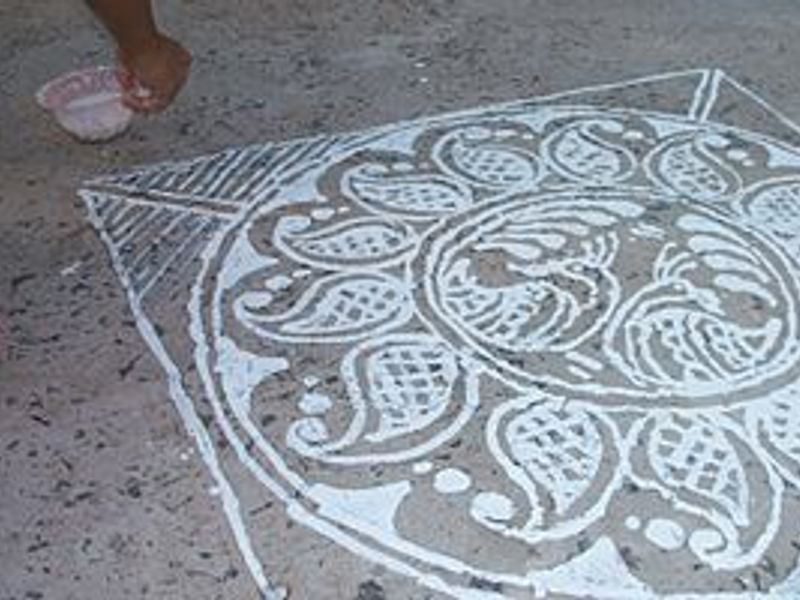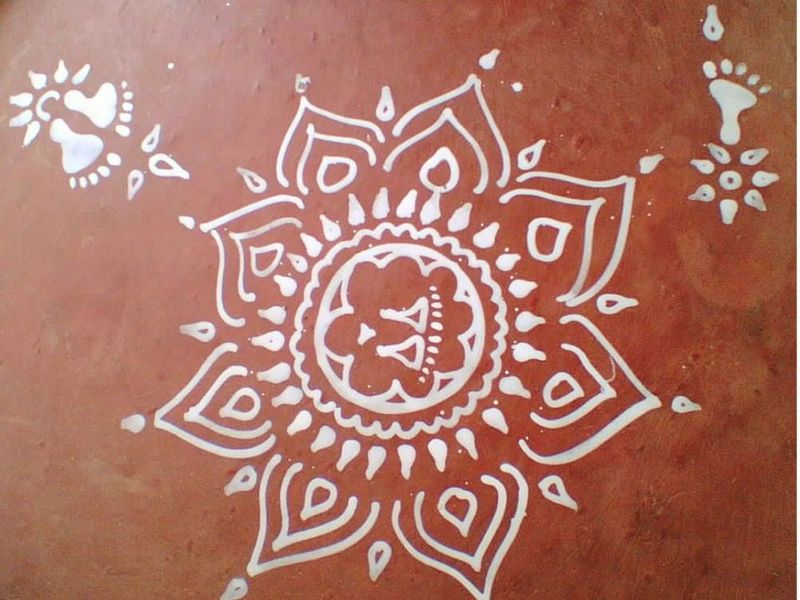Jhoti Chita: Odisha Art on Floor and Wall
Jhoti Chita is a traditional Odia art form, deeply rooted in rural culture. While it may resemble rangoli, it stands out with its unique use of a white colour, semi-liquid paste made from rice, known as pithau, instead of the colourful powders used in rangoli. This art is often created on both walls and floors, playing a significant role in festivals such as Lakshmi Puja, Durga Puja, and Kaartika, as well as during weddings and other social occasions.
Making of Jhoti Chita
The intricate art of Jhoti Chita is created using rice paste and a piece of cloth wrapped around a stick for a better grip. Women often craft these beautiful designs with their bare fingers, dipping them into the rice paste to trace intricate patterns on floors and walls. Occasionally, a brush made from a twig with a small piece of cloth attached is used for drawing. The paste is sometimes sprinkled onto walls in delicate swirls. Jhoti Chita can be seen on grain bins, small pavilions for household deities, and the thresholds of homes. The background, known as "Dhau," is typically an earthy red, smeared on walls or floors before the designs are applied. On walls, Jhoti is commonly found on the outer walls of huts or homes, often featuring triangular forms representing "Dhana Shishas"—heaps of paddy after winnowing. These are drawn by gently swirling the wrist to create long lines, with dots made by fingertips using the semi-liquid rice paste.
Symbolism in Jhoti Chita
Most motifs and designs in Jhoti Chita hold deep symbolic significance, with specific patterns used for various occasions. During Lakshmi Puja, for instance, a pyramid-shaped stack of paddy or rice sheaves is drawn on the walls, accompanied by painted footprints to signify the presence of Goddess Lakshmi. For Durga Puja, white dots overlaid with red are painted, colour combination symbolising deity Shiva and Shakti. As mentioned earlier, Dhana Sidha represents paddy, while symbols of Lord Jagannath and Lord Vishnu, such as the lotus flower, wheel, conch shell, and mace (gada), are also prominent in Jhoti Chita. Intricate designs of animals like elephants, kumbh, and fish, commonly seen in Pattachitra, are featured in this freehand drawing style. One of the most detailed and captivating motifs is the Swapna Padma Chita, a large, circular design. Since these designs represent deities, they are never swept away but instead carefully wiped with a wet cloth.
Festival of Mahabasa Gurubara and Jhoti Chita
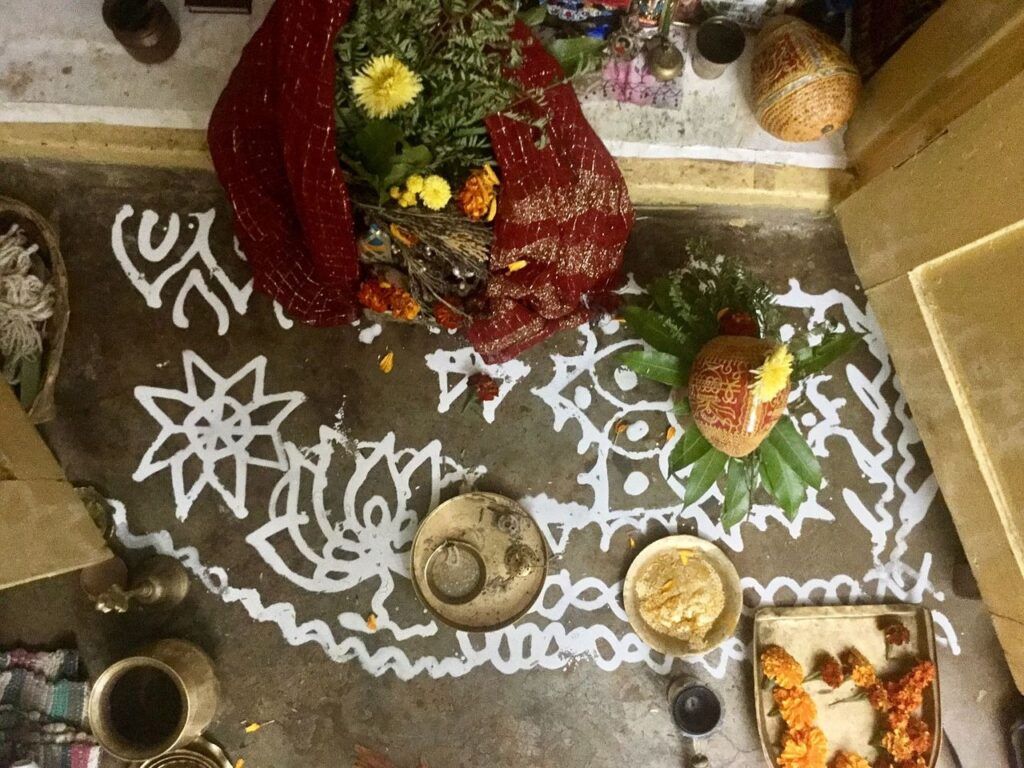
Jhoti Chita in Manabasa Gurubara (image source: Caleidoscope)
Manabasa Gurubara, celebrated in Odisha during the month of Margasira, is a significant festival honouring Goddess Lakshmi, the Hindu goddess of wealth and prosperity. It is believed that during this harvest month, Goddess Lakshmi visits homes, bringing blessings. Every Thursday, women perform the Lakshmi Brata, known as Manabasa Gurubara Brata, and the festival centres around the Lakshmi Purana. A well-known legend tells of a sweeper woman whose devotion and cleanliness impressed Goddess Lakshmi, who blessed her with wealth. The Lakshmi Purana also highlights a time when people from lower castes were not allowed to worship gods. A lower-caste woman bravely worshipped Lakshmi, who supported her and ended caste-based discrimination. This angered Lord Jagannath's brother, Lord Balabhadra, who forced Lakshmi to leave their home. Without her, both Jagannath and Balabhadra faced severe hardship, going without food and water for 12 years. Eventually, they realised their mistake and begged for her return. Lakshmi agreed to come back but only on the condition that caste-based discrimination would be abolished. This entire series of events, guided by divine wisdom, was meant to teach a lesson about equality and true spirituality.
As part of the festival, women clean their homes and create Jhoti Chita designs, including Laxmi Pada Chita (symbolic footprints), to welcome the goddess. A jar filled with newly harvested paddy, called Mana, is placed in the centre of the design, and traditional dishes like Chitau, Manda Pitha, Kakara, and Khiri are prepared. Women also recite the Lakshmi Purana with devotion. The Jhoti Chita art form, reflecting Odisha's cultural and religious beliefs, is practised by both rural and urban women. Despite being temporary, these intricate floor and wall paintings are recreated every year, preserving their importance across generations.
Muruja
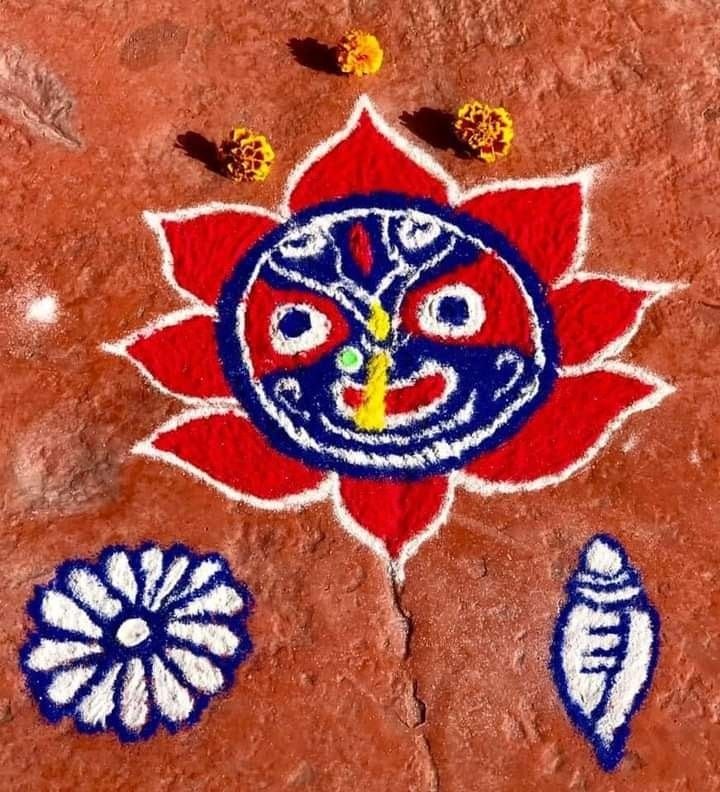
Muruja in kartik month (image source: Medium)
Along with Jhoti Chita, another traditional art form from Odisha is Muruja, which is commonly used in rituals, especially in the form of mandalas. Unlike Jhoti Chita, which is usually created in white, Muruja incorporates vibrant colours made from natural sources. White powder is obtained from grinding stones, green from dried leaves, black from burnt coconut shells, yellow from marigold petals or turmeric, and red from clay or bricks. Some women even create Muruja designs using only flowers. During the holy month of Kartik, women observe penance and draw intricate Muruja patterns near the Tulsi plant. The technique involves holding the powder between the thumb and forefinger, allowing it to fall delicately to form intricate lines and patterns. These colourful designs are a visual treat and showcase the remarkable skill of the women who practise this traditional art form.
Role of Women in Jhoti Chita
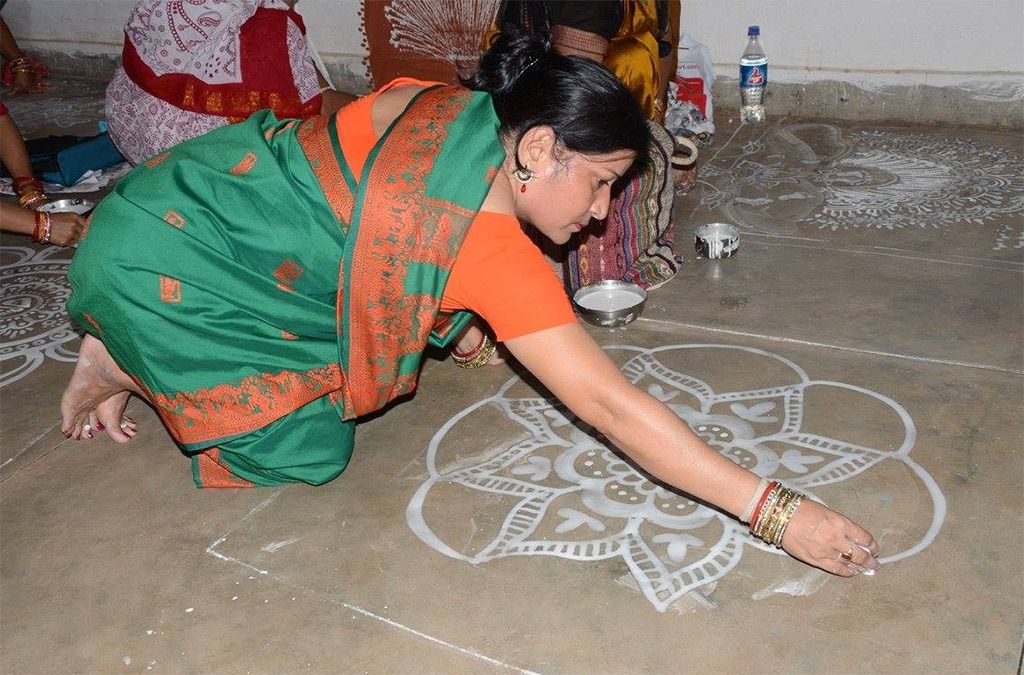
women making jhoti chita (image source: Caleidoscope)
Like many traditional art forms, the women of rural Odisha are the backbone of Jhoti Chita, keeping the practice alive through their dedication and creativity. Married women, in particular, are the primary custodians and artists who create these intricate designs. Their artistic skills passed down through generations, are showcased in the beautiful motifs and patterns they meticulously draw. The connection of Jhoti Chita to the worship of Goddess Lakshmi further highlights the significance of women in the preservation of this art. Since the paintings are a form of devotion, symbolising the goddess’s blessings and prosperity, women play a vital role in both its creation and cultural sustenance.
In Conclusion,
In modern times, Jhoti Chita and similar folk arts are practised more regularly by rural women, while urban women often engage with these traditions during festivals or rangoli competitions. In cities, traditional rice paste is replaced by white chalk powder. To preserve and promote this fading art, cultural organisations like the Odisha chapter of Sanskar Bharati frequently conduct rangoli festivals in Bhubaneswar, the state capital. Such festivals not only highlight the artistry but also encourage communities to stay connected to their roots. For instance, participants often decorate entire streets with a wide array of designs, creating vibrant displays that engage and inspire passersby. Similar initiatives in Cuttack, where local organisations adorned walls with Chita art, have brought new cultural pride to the city.
To learn more about Indian art and artists, download the Rooftop app from the App Store or Google Play to stay updated on our upcoming art events and workshops. Stay tuned to rooftop blogs and follow us on @rooftop_app.
By Shrushti Patel
